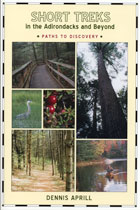
Book published by Nicholas K Burns Publishing
Want some help with your website content optimization? If you’re lucky enough to have a bookstore nearby, go there sometime and watch people browse the aisle. Or, notice how you pick a certain title from of all the thousands of books offered for sale on the store's shelves.
My book publishing company has eight titles still in the marketplace (seven have sold out). There are two children’s books, three histories, a “how-to,” a hiking guide, and a true crime. I have published each of my books with the same sales structure. My secrets are based on the fact that I have very little time to influence a purchasing decision by a customer in the bookstore.
The elements of the book designed to please that customer are very helpful to think about when planning the publication of your website. Actually, a website is easier. Publication online doesn’t mean printing, so you can make powerful changes to your current site with little problem and much less expense.
So what are some of the simple secrets book publishers know that draw their audience to the title? And how will they work for your website? (We’ll think in terms of non-fiction because this category, of course, represents most websites.)
Here are four…
1. People judge a book by its title. People will judge your website by its headline.
The book’s title lets customers know if it’s something they’re interested in. If its vague or too cute, they won’t pick it up.
For example, one of my titles is, “Short Treks in the Adirondacks and Beyond.” It’s about, well, short hikes. Where? In and around the Adirondacks. Takes just a split second to figure out if this book is for you. Try to do the same with your website’s title, the headline. My content writing website headline is, “Get a Winning Content Strategy PLUS the Special SEO Writing to Make it Work.” It’s about content strategy and SEO writing. See…quick and easy.
2. A book has a Table of Contents to quickly let readers know what’s inside. Your website visitors want to quickly know what’s inside your site, too.
You’ll find in the Table of Contents where each category of text is. Your website’s home page should be its Table of Contents. First time visitors won’t know if you offer the products/services that will help them solve their problems without a quick reference.
“Short Treks” lists in the Table of Contents its hikes: Fernow Forrest, Spring Pond Bog, Tenant Creek and more. My website links to my content writing services: Blog, Social Media, Video and more. In both you know right up front what you can get.
3. A shopper buys a book because of its back cover copy. Your website visitor wants to know how you can help.
The text here sparks interest in the book by quickly telling what it’s about and how the reader will benefit. Your homepage starts off with a lead consisting of clear, descriptive, and useful text letting your visitor in on what the site is about and how she will benefit.
4. A book has an About the Author page to boost credibility. Your website does, too.
The About the Author page adds a personal touch and credibility to the information offered in the text. Your website does the same with its About Us page. It’s here that you introduce yourself on a more personal level. And you let your visitors know your experience and how it makes you the right person to solve their problems.
Publishers have known for years what it takes to get a buyer interested in their book amongst all the competing titles in the bookstore. Take it from their experience, you should also think about the last book you purchased and incorporate that thinking into your own website.
Can you think of other ways the content on your optimized website and the last book you read are structured similarly?
Until next time,
Nick
Nick Burns is an SEO web writer specializing in persuasive copywriting and content marketing. He provides clients a winning content strategy plus the special web writing to make it work. You can contact Nick here.
